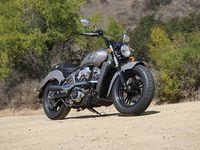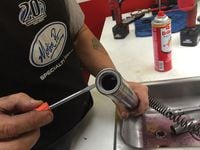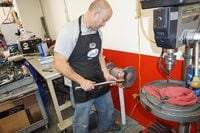WRIST: Brian Hatano
MSRP (2015): $11,299
MILES: 6,283
MPG: 39
MODS: K-Tech Suspension fork cartridges and shocks
What a difference a year makes! Right around this time last year, the Scout was unveiled at Sturgis, and new owners were mod-hungry from the start. But the aftermarket well was dry for the first few months, and the only source for upgrades was the Indian accessories catalog. I was genuinely concerned that finding aftermarket stuff for a long-term project might be a challenge. Pretty silly, huh?
This time, a suspension upgrade. "The geometry is dialed," Editor At Large Aaron Frank said in his First Ride review. "The springs, however, are soft at both ends, suggesting a beginner-biased setup." And after 6,000-plus miles on my long-term bike, that assessment has proved to be spot on. With the limited travel of its lay-down geometry and soft springs, the Scout rear suspension would sometimes bottom in a sharp dip at speeds above 60 mph.
K-Tech Suspension (orientexpress.com) is well-established in roadracing and motocross suspension components, and the company has recently started expanding into the American V-twin market with a fully adjustable Tracker fork cartridge kit ($895), replacement fork springs ($124), and nitrogen gas-charged, springless Bullit rear shocks ($795) for the Indian Scout.
To learn more about the K-Tech components and to have them installed on the Scout, I took a ride out to Motorcycle Service Centers (motorcycleservicecenters.com) in Camarillo, California. MSC is K-Tech's only authorized service and tuning center on the West Coast. They can install the Tracker fork cartridges with same-day ride-in, ride-out service (by appointment), or you can ship the components. MSC says that once they receive the fork legs, they can turn around and return them with the K-Tech Tracker kit installed in two days max. So with overnight shipping both ways, you can have adjustable K-Tech forks on your Scout within a week.
MSC owner Will Kenefick installed the Tracker cartridge kit and K-Tech replacement springs, pointing out that the kit requires a permanent fork modification so there’s no going back to stock. K-Tech strongly recommends that Tracker buyers have the kit installed by one of their service centers ($300), and while Will made the installation look simple, there were a couple of steps that would challenge even a skilled DIY mechanic.
On the ride home I immediately noticed an improvement in the Scout’s ability to glide over rough patches without transmitting the harsh jolts like before. The Tracker kit adds 30 detents of adjustability on each fork leg (compression on one side and rebound on the other). I kept the settings at 15 clicks, which is what K-Tech recommends until you acclimate to the changes.
If you’ve done the math, $2,114 for the Tracker kit, springs, Bullit shocks, and installation isn’t a low-budget upgrade. If I were coming out of pocket, I would start off with the Bullit shocks first. Not only are they an easy bolt-on, but they’re designed specifically for stroke-limited applications like the Scout and would solve my issue with (and pain from) the sudden bottoming of the soft stock shock. Only if I planned to keep the Scout as a daily rider for many years would I dig deeper to buy the Tracker cartridges and springs. But if the Scout were a weekend cruiser, I would most likely add the Bullits and call it a day.
I asked Senior Road Test Editor Ari Henning to give the Scout a before-and-after evaluation of the K-Tech upgrade, and this is what he had to say:
ARI HENNING, SENIOR ROAD TEST EDITOR
AGE: 30
HEIGHT: 5'10"
WEIGHT: 175 lb.
INSEAM: 33 in.
BEFORE: I think the stock setup is actually quite good for a cruiser, definitely above average. A little soft in terms of spring rates and damping but not sloppy loose and a very compliant straight-line ride, except for over hard-edged stuff where it felt harsh. It wallows a bit in fast sweepers (freeway entrance/exit ramps) and bounces after hitting bigger bumps—all signs of limited/quick rebound damping.
AFTER: The new setup still feels appropriately compliant, and the high-speed compression is much improved. The fork is not nearly as harsh over hard-edged stuff, which really helps with the ride quality. There's a bit more rebound damping (especially in the shocks), so the bike doesn't pogo after hitting a larger bump/dip, and the chassis stays calmer while cornering.
















/cloudfront-us-east-1.images.arcpublishing.com/octane/2WF3SCE3NFBQXLDNJM7KMXA45E.jpg)
/cloudfront-us-east-1.images.arcpublishing.com/octane/G4MG6OUCJNBSHIS2MVVOTPX65E.jpg)
/cloudfront-us-east-1.images.arcpublishing.com/octane/IIGGWFOTOJGB7DB6DGBXCCMTDY.jpg)
/cloudfront-us-east-1.images.arcpublishing.com/octane/QSTCM6AVEZA5JJBUXNIQ3DSOF4.jpg)
/cloudfront-us-east-1.images.arcpublishing.com/octane/U4I7G625B5DMLF2DVIJDFZVV6M.jpg)
/cloudfront-us-east-1.images.arcpublishing.com/octane/B6XD6LS6IVCQPIU6HXDJSM3FHY.jpg)
/cloudfront-us-east-1.images.arcpublishing.com/octane/ICL63FEDDRDTTMINYICCEYGMDA.jpg)
/cloudfront-us-east-1.images.arcpublishing.com/octane/FCGZHQXRBZFLBAPC5SDIQLVF4I.jpg)
/cloudfront-us-east-1.images.arcpublishing.com/octane/WNOB6LDOIFFHJKPSVIWDYUGOPM.jpg)

/cloudfront-us-east-1.images.arcpublishing.com/octane/X33NU3E525ECRHXLNUJN2FTRKI.jpg)
/cloudfront-us-east-1.images.arcpublishing.com/octane/6KKT5NNL2JAVBOXMZYS5ZO76YA.jpg)
/cloudfront-us-east-1.images.arcpublishing.com/octane/J5RKG5O455GMPGQRF2OG6LRT7A.jpg)
/cloudfront-us-east-1.images.arcpublishing.com/octane/GX2CIZKQVRH2TATDM26KFG2DAE.jpg)
/cloudfront-us-east-1.images.arcpublishing.com/octane/ZWIDYSAKQZHD5BHREMQILXJCGM.jpg)
/cloudfront-us-east-1.images.arcpublishing.com/octane/CYUHJZCTSJCH3MRAQEIKXK7SCQ.jpg)
/cloudfront-us-east-1.images.arcpublishing.com/octane/LKOFINY56FCXJCANJ5M7ZDQUBY.jpg)
/cloudfront-us-east-1.images.arcpublishing.com/octane/4NBPDACMWJH63JQYJVK3QRBDZI.jpg)
/cloudfront-us-east-1.images.arcpublishing.com/octane/KKHQHRR3FJGX7H2IPU6RALMWG4.jpg)

/cloudfront-us-east-1.images.arcpublishing.com/octane/5IOFS5JAE5FOXMNA23ZRAVVYUU.jpg)
/cloudfront-us-east-1.images.arcpublishing.com/octane/CGXQ3O2VVJF7PGTYR3QICTLDLM.jpg)

/cloudfront-us-east-1.images.arcpublishing.com/octane/OQVCJOABCFC5NBEF2KIGRCV3XA.jpg)